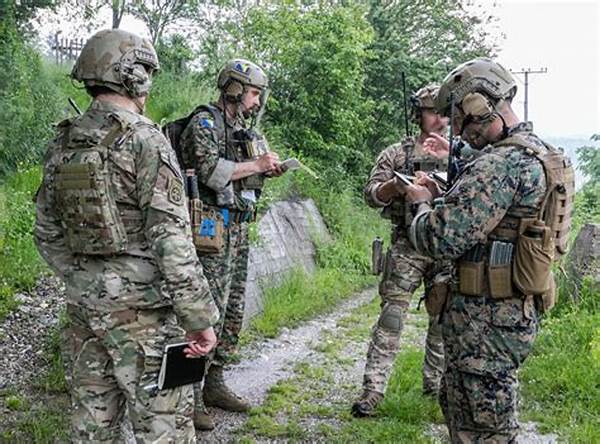Introduction to Combined Special Forces Training Missions
Combined special forces training missions represent an essential component of modern military strategy, aimed at enhancing cooperation and interoperability among diverse armed units. These missions involve the collaboration of specialized units trained to operate in complex and high-risk environments. By integrating personnel from different countries and military branches, these exercises strengthen diplomatic ties and augment the overall defensive readiness of participating nations. The focus of these missions is to unify tactical capabilities, foster mutual understanding, and develop joint operational strategies that can be deployed in real-world scenarios.
In recent years, the frequency and complexity of combined special forces training missions have increased significantly. This shift is largely driven by the evolving nature of global threats, which necessitates a collaborative approach to security. Through these missions, special forces units engage in a variety of exercises, ranging from urban warfare simulations to counter-terrorism tactics. These training initiatives provide invaluable opportunities for participating nations to exchange knowledge, refine their methodologies, and improve their strategic responses to emerging challenges.
The advantages of combined special forces training missions are manifold. They not only enhance the technical proficiency of individual units but also promote cultural exchange and understanding among different military cultures. This collective effort ultimately contributes to a more coordinated and effective response to global security threats, reinforcing the importance of international military collaboration in maintaining peace and stability.
Key Components of Combined Special Forces Training Missions
1. Interoperability Development: These missions aim to enhance the ability of different forces to operate together effectively, ensuring seamless coordination in joint operations.
2. Tactical Proficiency Enhancement: Specialized units focus on improving their skills and techniques, benefiting from diverse training environments and scenarios.
3. Knowledge and Skill Exchange: Participating forces share insights and strategies, enhancing their collective operational capabilities.
4. Cultural Exchange: These missions offer opportunities for military personnel to learn from one another, fostering mutual respect and understanding.
5. Joint Strategic Planning: Through combined special forces training missions, units develop cohesive plans to address a wide range of security threats efficiently.
The Strategic Importance of Combined Special Forces Training Missions
Combined special forces training missions are of paramount importance in today’s security landscape. By fostering cooperation among elite units of various nations, these missions play a critical role in enhancing global security frameworks. They allow participating forces to develop a comprehensive understanding of the tactics and strategies employed by different nations, helping them operate under unified command structures.
The emphasis on joint exercises in combined special forces training missions is instrumental in preparing units for potential real-world deployments. These exercises are meticulously designed to simulate a wide array of combat scenarios, from insurgency suppression to hostage rescues. This practical experience is invaluable in testing the readiness and adaptability of special forces, ultimately contributing to their effectiveness in future operations.
Through these missions, participating nations can build trust and foster stronger alliances. This enhanced cooperation is crucial in addressing transnational threats that require a collective response. The success of combined special forces training missions underscores the need for continued investment in joint military exercises to maintain a robust and collaborative global security environment.
Challenges and Solutions in Combined Special Forces Training Missions
Combined special forces training missions, while highly beneficial, do present several challenges that need to be addressed. These include logistical barriers, such as coordinating the movement and supply of personnel across international borders, which can be complex and resource-intensive. To mitigate these challenges, participating nations often establish dedicated coordination centers to streamline operations.
Additionally, language barriers and differing standard operating procedures can pose obstacles during training missions. By engaging in extensive pre-mission briefings and using interpreters, these challenges are often overcome. The use of common tactical protocols also assists in creating a cohesive operational environment during these combined exercises.
Moreover, ensuring the safety of personnel during high-risk training activities is paramount. Risk assessments and stringent safety protocols are essential in minimizing potential dangers. By addressing these challenges effectively, combined special forces training missions can continue to succeed in their objective of strengthening global military partnerships and enhancing operational readiness.
Technological Advancements in Combined Special Forces Training Missions
The integration of advanced technology plays a crucial role in the effectiveness of combined special forces training missions. Technological advancements, such as virtual reality simulations and AI-driven analytics, enable units to conduct highly realistic training exercises in a controlled environment. These innovations allow for detailed after-action reviews, providing invaluable insights for continuous improvement.
The use of drones and robotics in these missions has transformed the way special forces units operate. These technologies offer enhanced reconnaissance and intelligence-gathering capabilities, providing a strategic advantage during training and actual operations. This technological integration is pivotal in preparing units to face modern security challenges effectively.
Furthermore, secure communication systems are vital in coordinating operations across multiple forces. Ensuring seamless information exchange is critical for the successful execution of combined special forces training missions, emphasizing the importance of continued investment in technology to support joint military endeavors.
Future Prospects of Combined Special Forces Training Missions
As geopolitical dynamics continue to evolve, the role of combined special forces training missions in global security is likely to increase. Future missions will undoubtedly incorporate even more sophisticated technology and complex training scenarios to address emerging threats. With a focus on adaptability and innovation, these missions will continue to enhance the capabilities of special forces units worldwide.
The expansion of these training programs to include more nations is anticipated, further strengthening global military alliances. This inclusivity will promote a more comprehensive approach to international security, fostering collaboration and understanding among diverse forces. The ongoing success of combined special forces training missions reaffirms their vital role in maintaining peace and stability on the global stage.
Conclusion: The Impact of Combined Special Forces Training Missions
In conclusion, combined special forces training missions are indispensable in today’s interconnected world. These missions not only enhance the tactical prowess of participating units but also promote international cooperation and understanding. By addressing both current and future security challenges, they contribute significantly to the global effort to maintain peace and security.
The continued evolution of these training missions underscores their importance in a rapidly changing geopolitical landscape. As nations face increasingly complex threats, the ability to work collaboratively and effectively through combined special forces training missions will remain a cornerstone of global security strategies. By fostering unity and cooperation, these missions pave the way for a safer and more secure world.





